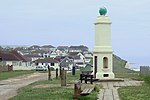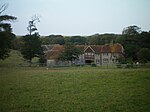Peacehaven & Telscombe F.C.
1923 establishments in EnglandAssociation football clubs established in 1923Brighton, Hove & District Football LeagueFan-owned football clubs in EnglandFootball clubs in East Sussex ... and 3 more
Football clubs in EnglandIsthmian LeagueSouthern Combination Football League
Peacehaven & Telscombe Football Club is a football club based in Peacehaven, East Sussex, England. The club is affiliated to the Sussex County Football Association. The club are currently members of the Southern Combination Premier Division and play at the Sports Park.
Excerpt from the Wikipedia article Peacehaven & Telscombe F.C. (License: CC BY-SA 3.0, Authors).Peacehaven & Telscombe F.C.
Bridleway Peacehaven 7a,
Geographical coordinates (GPS) Address Nearby Places Show on map
Geographical coordinates (GPS)
| Latitude | Longitude |
|---|---|
| N 50.793447222222 ° | E 0.012933333333333 ° |
Address
Peacehaven & Telscombe FC
Bridleway Peacehaven 7a
BN10 8RH , Peacehaven
England, United Kingdom
Open on Google Maps








